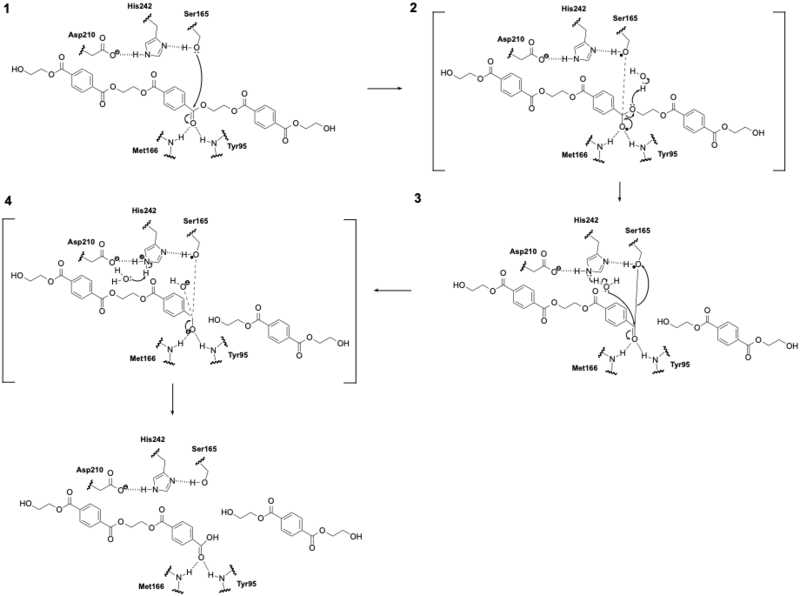Sandbox Reserved 1844
From Proteopedia
(Difference between revisions)
| Line 27: | Line 27: | ||
=== Ligand Binding Pocket === | === Ligand Binding Pocket === | ||
| - | The <scene name='10/1075246/4eb0_with_colored_ligand_stick/5'>substrate-binding site</scene> of LCC is a long, mainly hydrophobic groove that accommodates PET chains. This groove includes three subsites—designated −2, −1, and + | + | The <scene name='10/1075246/4eb0_with_colored_ligand_stick/5'>substrate-binding site</scene> of LCC is a long, mainly hydrophobic groove that accommodates PET chains. This groove includes three subsites—designated <scene name='10/1075246/4eb0_ligand_subsites/1'>−2, −1, and +1</scene>—that interact with specific PET units near the scissile ester bond. Hydrophobic residues such as <scene name='10/1075248/4eb0_with_colored_ligand_stick/2'>F125, V212, M166, and F243</scene> line the groove and facilitate binding by interacting with the [https://en.wikipedia.org/wiki/Aromatic_compound aromatic] rings of the PET molecule. These interactions help align the substrate in the correct position for catalysis. |
The <scene name='10/1075248/4eb0_surface_w_stick_ligand/1'>molecular surface view of the enzyme-ligand interaction</scene> shows the overall shape and depth of the binding groove. The <scene name='10/1075246/4eb0_hydrophobicity_ligand/3'>cartoon representation of the enzyme-ligand interaction</scene>, the enzyme is shown as a ribbon diagram with the hydrophobic residues colored pink, to show how the PET chain fits snugly into the groove. | The <scene name='10/1075248/4eb0_surface_w_stick_ligand/1'>molecular surface view of the enzyme-ligand interaction</scene> shows the overall shape and depth of the binding groove. The <scene name='10/1075246/4eb0_hydrophobicity_ligand/3'>cartoon representation of the enzyme-ligand interaction</scene>, the enzyme is shown as a ribbon diagram with the hydrophobic residues colored pink, to show how the PET chain fits snugly into the groove. | ||
Revision as of 19:56, 17 April 2025
| This Sandbox is Reserved from March 18 through September 1, 2025 for use in the course CH462 Biochemistry II taught by R. Jeremy Johnson and Mark Macbeth at the Butler University, Indianapolis, USA. This reservation includes Sandbox Reserved 1828 through Sandbox Reserved 1846. |
To get started:
More help: Help:Editing |
Leaf Branch Compost Cutinase
| |||||||||||
References
- ↑ 1.0 1.1 1.2 1.3 1.4 1.5 1.6 1.7 Tournier V, Topham CM, Gilles A, David B, Folgoas C, Moya-Leclair E, Kamionka E, Desrousseaux ML, Texier H, Gavalda S, Cot M, Guemard E, Dalibey M, Nomme J, Cioci G, Barbe S, Chateau M, Andre I, Duquesne S, Marty A. An engineered PET depolymerase to break down and recycle plastic bottles. Nature. 2020 Apr;580(7802):216-219. doi: 10.1038/s41586-020-2149-4. Epub 2020 Apr, 8. PMID:32269349 doi:http://dx.doi.org/10.1038/s41586-020-2149-4
- ↑ 2.0 2.1 2.2 2.3 2.4 Sui B, Wang T, Fang J, Hou Z, Shu T, Lu Z, Liu F, Zhu Y. Recent advances in the biodegradation of polyethylene terephthalate with cutinase-like enzymes. Front Microbiol. 2023 Oct 2;14:1265139. PMID:37849919 doi:10.3389/fmicb.2023.1265139
- ↑ Ueda H, Tabata J, Seshime Y, Masaki K, Sameshima-Yamashita Y, Kitamoto H. Cutinase-like biodegradable plastic-degrading enzymes from phylloplane yeasts have cutinase activity. Biosci Biotechnol Biochem. 2021 Jul 23;85(8):1890-1898. PMID:34160605 doi:10.1093/bbb/zbab113
- ↑ Kolattukudy PE. Biopolyester membranes of plants: cutin and suberin. Science. 1980 May 30;208(4447):990-1000. PMID:17779010 doi:10.1126/science.208.4447.990
- ↑ 5.0 5.1 5.2 5.3 5.4 Khairul Anuar NFS, Huyop F, Ur-Rehman G, Abdullah F, Normi YM, Sabullah MK, Abdul Wahab R. An Overview into Polyethylene Terephthalate (PET) Hydrolases and Efforts in Tailoring Enzymes for Improved Plastic Degradation. Int J Mol Sci. 2022 Oct 20;23(20):12644. PMID:36293501 doi:10.3390/ijms232012644
- ↑ 6.0 6.1 Burgin T, Pollard BC, Knott BC, Mayes HB, Crowley MF, McGeehan JE, Beckham GT, Woodcock HL. The reaction mechanism of the Ideonella sakaiensis PETase enzyme. Commun Chem. 2024 Mar 27;7(1):65. PMID:38538850 doi:10.1038/s42004-024-01154-x
- ↑ The protein is an LCC mutant that has been optimized for thermostability. The model substrate is 2-HE(MHET)₃, a trimer of MHET (mono-(2-hydroxy-ethyl) terephthalate). MHET is an intermediate in the depolymerization of PET.<ref>PMID:37945666</li> <li id="cite_note-Zhang-7">↑ <sup>[[#cite_ref-Zhang_7-0|8.0]]</sup> <sup>[[#cite_ref-Zhang_7-1|8.1]]</sup> Stevensen J, Janatunaim RZ, Ratnaputri AH, Aldafa SH, Rudjito RR, Saputro DH, Suhandono S, Putri RM, Aditama R, Fibriani A. Thermostability and Activity Improvements of PETase from Ideonella sakaiensis. ACS Omega. 2025 Feb 12;10(7):6385-6395. PMID:[https://www.ncbi.nlm.nih.gov/pubmed/40028137 40028137] doi:[https://dx.doi.org/10.1021/acsomega.4c05142 10.1021/acsomega.4c05142]</li> <li id="cite_note-Yoshida-8">[[#cite_ref-Yoshida_8-0|↑]] Yoshida S, Hiraga K, Takehana T, Taniguchi I, Yamaji H, Maeda Y, Toyohara K, Miyamoto K, Kimura Y, Oda K. A bacterium that degrades and assimilates poly(ethylene terephthalate). Science. 2016 Mar 11;351(6278):1196-9. doi: 10.1126/science.aad6359. PMID:[http://www.ncbi.nlm.nih.gov/pubmed/26965627 26965627] doi:[http://dx.doi.org/10.1126/science.aad6359 http://dx.doi.org/10.1126/science.aad6359]</li> <li id="cite_note-Landrigan-9">[[#cite_ref-Landrigan_9-0|↑]] Landrigan PJ, Stegeman JJ, Fleming LE, Allemand D, Anderson DM, Backer LC, Brucker-Davis F, Chevalier N, Corra L, Czerucka D, Bottein MD, Demeneix B, Depledge M, Deheyn DD, Dorman CJ, Fénichel P, Fisher S, Gaill F, Galgani F, Gaze WH, Giuliano L, Grandjean P, Hahn ME, Hamdoun A, Hess P, Judson B, Laborde A, McGlade J, Mu J, Mustapha A, Neira M, Noble RT, Pedrotti ML, Reddy C, Rocklöv J, Scharler UM, Shanmugam H, Taghian G, van de Water JAJM, Vezzulli L, Weihe P, Zeka A, Raps H, Rampal P. Human Health and Ocean Pollution. Ann Glob Health. 2020 Dec 3;86(1):151. PMID:[https://www.ncbi.nlm.nih.gov/pubmed/33354517 33354517] doi:[https://dx.doi.org/10.5334/aogh.2831 10.5334/aogh.2831]</li> <li id="cite_note-Jambeck-10">[[#cite_ref-Jambeck_10-0|↑]] Jambeck JR, Geyer R, Wilcox C, Siegler TR, Perryman M, Andrady A, Narayan R, Law KL. Marine pollution. Plastic waste inputs from land into the ocean. Science. 2015 Feb 13;347(6223):768-71. PMID:[https://www.ncbi.nlm.nih.gov/pubmed/25678662 25678662] doi:[https://dx.doi.org/10.1126/science.1260352 10.1126/science.1260352]</li></ol></ref>
Student Contributors
Ashley Callaghan, Rebecca Hoff, & Simone McCowan


